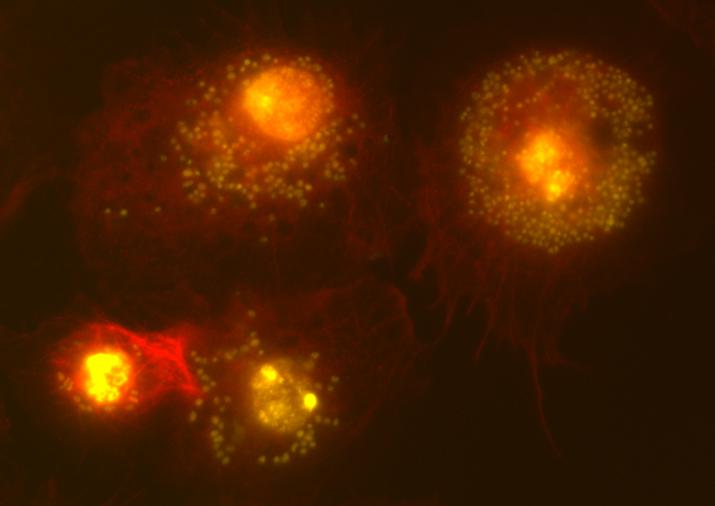Too much of a good thing: Extra genes make bacteria lethal

This image shows small yellow dots surrounding bright yellow cell nuclei in each cell are Wolbachia. The cytoskeleton (in red) allows seeing the shape of the cells. Credit: Ewa Chrostek (IGC)
In a new study published in the latest edition of the scientific journal PLOS Biology*, a research team from Instituto Gulbenkian de Ciencia (IGC; Portugal) found that a single genomic change can turn beneficial bacteria into pathogenic bacteria, by boosting bacterial density inside the host.
Ewa Chrostek and Luis Teixeira studied the symbiosis between a fruit fly (Drosophila melanogaster) and the bacterium Wolbachia to answer how benign bacteria become pathogenic. Wolbachia is present in most insect species and protects some of them against viruses, including the dengue fever virus.
Previous studies conducted by Luis Teixeira's team showed that the number of Wolbachia inside the fruit fly determines its effect on the host. Bacteria that reach very high levels inside the fly become harmful. Hence, this research team set out to investigate the genetic basis that control bacteria density inside the host and, consequently, their pathogenicity.
Comparison of pathogenic and non-pathogenic Wolbachia variants suggested that the number of repeats of a specific region of the genome, called Octomom, was causing the difference in Wolbachia virulence. The authors show that the number of copies of this region was variable between individual flies.
The bacteria with more Octomom copies grow faster reaching higher densities inside the fruit flies. Consequently, the more copies, the earlier the flies die. On the other hand, more copies of the Octomom region and higher Wolbachia levels in flies provide stronger antiviral protection.
Ewa Chrostek, who just finished her PhD at Luis Teixeira's laboratory, says: “We show that Octomom copy number can change rapidly, leading to different Wolbachia infection outcomes for the fly. These bacteria can evolve really fast and easily break away from hosts' control.”
Luis Teixeira explains further: “We discovered a region of the Wolbachia genome responsible for regulation of its densities in the flies. This is the first study linking genes and their functions in this bacteria and it provides a unique point of entry for the understanding of the widespread insect-Wolbachia symbiosis.”
Currently, as part of a strategy to control dengue transmission, mosquitoes (Aedes aegypti) infected with Wolbachia bacteria are being released in the wild. Therefore, understanding mechanisms of potential Wolbachia evolution and Wolbachia densities control is extremely important.
###
This research was carried out at Instituto Gulbenkian de Ciencia (Oeiras, Portugal). This study was funded by Fundacao para a Ciencia e a Tecnologia (Portugal) and the Wellcome Trust (UK).
* Ewa Chrostek and Luis Teixeira (2015). Mutualism breakdown by amplification of Wolbachia genes. PLOS Biology.
Media Contact
All latest news from the category: Life Sciences and Chemistry
Articles and reports from the Life Sciences and chemistry area deal with applied and basic research into modern biology, chemistry and human medicine.
Valuable information can be found on a range of life sciences fields including bacteriology, biochemistry, bionics, bioinformatics, biophysics, biotechnology, genetics, geobotany, human biology, marine biology, microbiology, molecular biology, cellular biology, zoology, bioinorganic chemistry, microchemistry and environmental chemistry.
Newest articles

A universal framework for spatial biology
SpatialData is a freely accessible tool to unify and integrate data from different omics technologies accounting for spatial information, which can provide holistic insights into health and disease. Biological processes…

How complex biological processes arise
A $20 million grant from the U.S. National Science Foundation (NSF) will support the establishment and operation of the National Synthesis Center for Emergence in the Molecular and Cellular Sciences (NCEMS) at…

Airborne single-photon lidar system achieves high-resolution 3D imaging
Compact, low-power system opens doors for photon-efficient drone and satellite-based environmental monitoring and mapping. Researchers have developed a compact and lightweight single-photon airborne lidar system that can acquire high-resolution 3D…





















